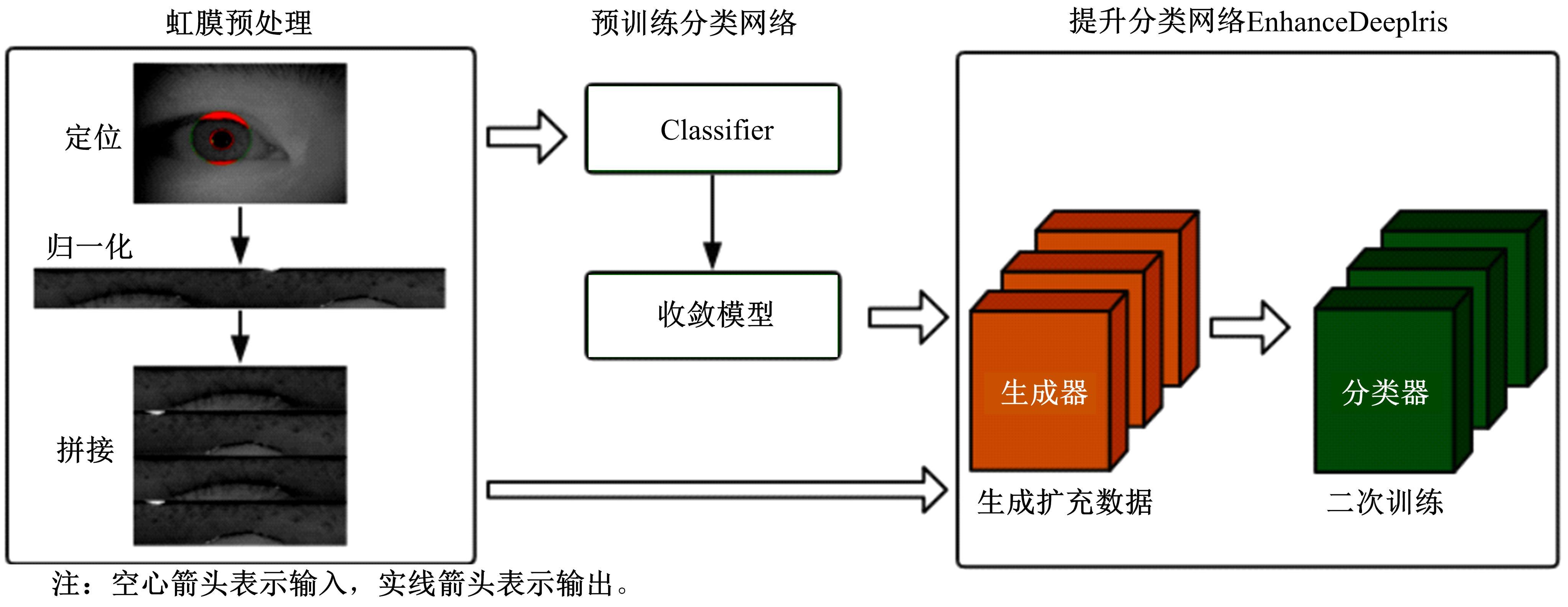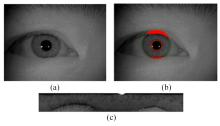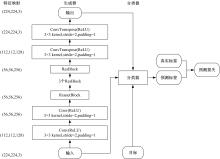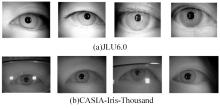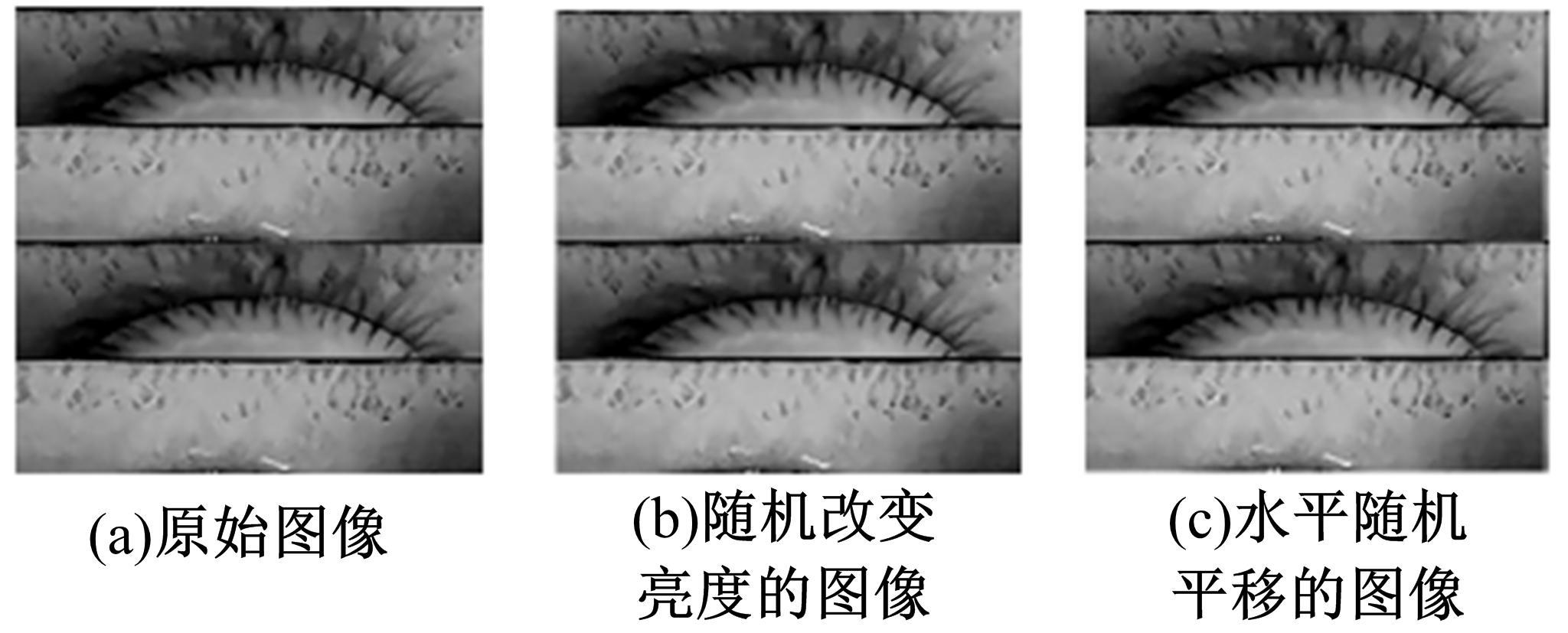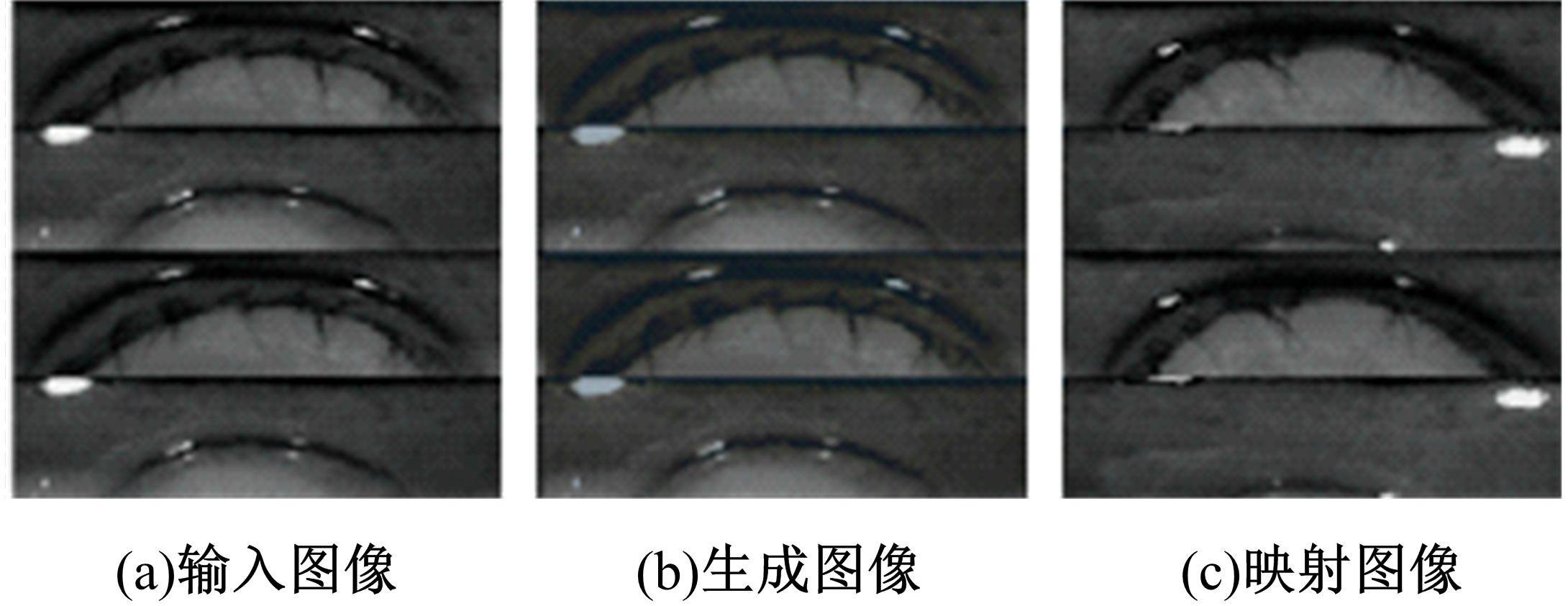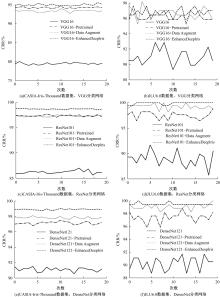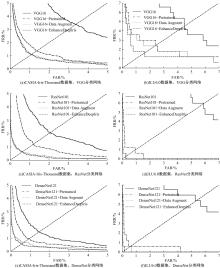吉林大学学报(工学版) ›› 2022, Vol. 52 ›› Issue (12): 2924-2932.doi: 10.13229/j.cnki.jdxbgxb20210438
基于生成模型提升训练的深度学习虹膜识别方法
刘元宁1,2( ),朱琳1,2,朱晓冬1,2(
),朱琳1,2,朱晓冬1,2( ),刘震1,3,吴浩萌1
),刘震1,3,吴浩萌1
- 1.吉林大学 计算机科学与技术学院,长春 130012
2.吉林大学 符号计算与知识工程教育部重点实验室,长春 130012
3.长崎综合科学大学 研究生院工学研究科,长崎 851-0193
Deep learning iris recognition method based on generative model boost training
Yuan-ning LIU1,2( ),Lin ZHU1,2,Xiao-dong ZHU1,2(
),Lin ZHU1,2,Xiao-dong ZHU1,2( ),Zhen LIU1,3,Hao-meng WU1
),Zhen LIU1,3,Hao-meng WU1
- 1.College of Computer Science and Technology,Jilin University,Changchun 130012,China
2.Key Laboratory of Symbolic Computation and Knowledge Engineering,Ministry of Education,Jilin University,Changchun 130012,China
3.Graduate School of Engineering,Nagasaki Institute of Applied Science,Nagasaki 851-0193,Japan
摘要:
提出了一种改进的深度虹膜分类模型EnhanceDeepIris,在生成网络的辅助下,对深度学习虹膜分类网络进行二次训练,使已经在原始训练集上收敛的分类网络继续训练,得到在测试集上泛化能力更好的网络。使用3个先进的图像分类网络VGG16、ResNet101和DenseNet121验证EnhanceDeepIris对深度学习分类网络的提升效果。在两个虹膜数据集CASIA-Iris-Thousand和JLU6.0上对该方法进行实验,结果表明,与传统数据增强方法相比,经过EnhanceDeepIris提升训练的分类模型识别精度更高、测试效果更稳定。
中图分类号:
- TP391.41
| 1 | Wildes R P. Iris recognition: an emerging biometric technology[J]. Proceedings of the IEEE, 1997, 85(9): 1348-1363. |
| 2 | Daugman J G. High confidence visual recognition of persons by a test of statistical independence[J]. IEEE Transactions on Pattern Analysis & Machine Intelligence, 1993, 15(11): 1148-1161. |
| 3 | Boles W W, Boashash B. A human identification technique using images of the iris and wavelet transform[J]. IEEE Transactions on Signal Processing, 1998, 46(4): 1185-1188. |
| 4 | Tian Qi-chuan, Pan Quan, Cheng Yong-mei, et al. Iris feature extracting algorithm based on zero-crossing detection[J]. Journal of Electronics and Information Technology, 2006, 28(8): 1452-1457. |
| 5 | Hollingsworth K P, Bowyer K W, Flynn P J. Improved iris recognition through fusion of hamming distance and fragile bit distance(article)[J]. IEEE Transactions on Pattern Analysis and Machine Intelligence, 2011, 33(12): 2465-2476. |
| 6 | 刘元宁,刘帅,朱晓冬,等. 基于高斯拉普拉斯算子与自适应优化伽柏滤波的虹膜识别[J]. 吉林大学学报:工学版, 2018, 48(5): 1606-1613. |
| Liu Yuan-ning, Liu Shuai, Zhu Xiao-dong, et al. Log operator and adaptive optimization gabor filtering for iris recognition[J]. Journal of Jilin University (Engineering and Technology Edition), 2018, 48(5): 1606-1613. | |
| 7 | 刘元宁,刘帅,朱晓冬,等. 基于决策粒子群优化与稳定纹理的虹膜二次识别[J]. 吉林大学学报:工学版, 2019, 49(4): 1329-1338. |
| Liu Yuan-ning, Liu Shuai, Zhu Xiao-dong, et al. Iris secondary recognition based on decision particle swarm optimization and stable texture[J]. Journal of Jilin University (Engineering and Technology Edition), 2019, 49(4): 1329-1338. | |
| 8 | Russakovsky O, Deng J, Su H, et al. Imagenet large scale visual recognition challenge[J]. International Journal of Computer Vision, 2015, 115(3): 211-252. |
| 9 | Krizhevsky A, Sutskever I, Hinton G. Imagenet classification with deep convolutional neural networks[J]. Communications of the ACM, 2017, 60(6): 84-90. |
| 10 | Simonyan K, Zisserman A. Very deep convolutional networks for large-scale image recognition[J/OL]. [2021-04-25]. |
| 11 | He Kai-ming, Zhang Xiang-yu, Ren Shao-qing, et al. Deep residual learning for image recognition[C]∥Proceedings of IEEE Conference on Computer Vision and Pattern Recognition (CVPR), Las Vegas, NV, USA, 2016: 770-778. |
| 12 | Huang G, Liu Z, van Der Maaten L, et al. Densely connected convolutional networks[C]∥IEEE Coference on Computer Vision and Pattern Recognition, Honolulu, HI, USA, 2017: 2261-2269. |
| 13 | Szegedy C, Liu W, Jia Y Q, et al. Going deeper with convolutions[C]∥Proceedings of IEEE Conference on Computer Vision and Pattern Recognition, Boston, MA, 2015: 1-9. |
| 14 | Liu N, Zhang M, Li H, et al. DeepIris: learning pairwise filter bank for heterogeneous iris verification[J]. Pattern Recognition Letters, 2015, 82(2): 154-161. |
| 15 | Gangwar A, Joshi A. Deepirisnet: deep iris representation with applications in iris recognition and cross-sensor iris recognition[C]∥IEEE International Conference on Image Processing, Phoenix, AZ, USA, 2016: 2301-2305. |
| 16 | Al-Waisy A S, Qahwaji R, Ipson S, et al. A multi-biometric iris recognition system based on a deep learning approach[J]. Pattern Analysis & Applications, 2018, 21(3): 783-802. |
| 17 | Zhao T, Liu Y, Huo G, et al. A deep learning iris recognition method based on capsule network architecture[J]. IEEE Access, 2019(7): 49691-49701. |
| 18 | Nguyen K, Fookes C, Ross A, et al. Iris recognition with off-the-shelf CNN features: a deep learning perspective[J]. IEEE Access, 2018(6): 18848-18855. |
| 19 | Goodfellow I J, Pouget-Abadie J, Mirza M, et al. generative adversarial networks[J]. Advances in Neural Information Processing Systems, 2014(3): 2672-2680. |
| 20 | 邹秀芳, 朱定局. 生成对抗网络研究综述[J]. 计算机系统应用, 2019, 28(11): 5-13. |
| Zou Xiu-fang, Zhu Ding-ju. Review of generative countermeasure network[J]. Computer Systems Applications, 2019, 28(11): 5-13 | |
| 21 | Zhu J Y, Park T, Isola P, et al. Unpaired image-to-image translation using cycle-consistent adversarial networks[C]∥Proceedings of the IEEE International Conference on Computer Vision (ICCV), Venice, Italy, 2017: 2242-2251. |
| 22 | Wang T C, Liu M Y, Zhu J Y, et al. High-resolution image synthesis and semantic manipulation with conditional GANS[C]∥Proceedings of the IEEE Computer Society Conference on Computer Vision & Pattern Recognition(CVPR), Salt Lake City, UT, USA, 2018: 8798-8807. |
| 23 | Liu G L, Reda F A, Shih K J, et al. Image inpainting for irregular holes using partial convolutions[C]∥European Conference on Computer Vision(ECCV), Munich, Germany, 2018: 89-105. |
| 24 | 陈英, 刘志鑫. 基于GAN的虹膜数据增强方法研究[J]. 信息通信, 2020, 214(10): 36-40. |
| Chen Ying, Liu Zhi-xin. Research on iris data enhancement method based on GAN[J]. Information & Communications, 2020, 214(10): 36-40. | |
| 25 | Waheed A, Goyal M, Gupta D, et al. Covid GAN: Data augmentation using auxiliary classifier GAN for improved covid-19 detection[J]. IEEE Access, 2020(8): 91916-91923. |
| 26 | Chinese academy of sciences institute of automation. CASIA iris image database[DB/OL]. [2021-04-30]. |
| 27 | Othman N, Dorizzi B, Garcia-Salicetti S. OSIRIS: an open source iris recognition software[J]. Pattern Recognition Letters, 2016(82): 124-131. |
| 28 | 程广涛, 巩家昌, 赵洪伟. 基于膨胀卷积和稠密连接的烟雾识别方法[J]. 计算机工程, 2020, 46(4): 253-259. |
| Cheng Guang-tao, Gong Jia-chang, Zhao Hong-wei. Smoke recognition method based on dilated convolution and dense connection[J]. Computer Engineering, 2020, 46(4): 253-259. | |
| 29 | 袁自勇, 高曙, 曹姣, 等. 基于异构图卷积网络的小样本短文本分类方法[J]. 计算机工程, 2021, 47(12): 87-94. |
| Yuan Zi-yong, Gao Shu, Cao Jiao, et al. Method for few-shot short text classification based on heterogeneous graph convolutional network[J]. Computer Engineering, 2021, 47(12): 87-94. | |
| 30 | 袁梅, 全太锋, 黄俊, 等. 基于卷积神经网络的烟雾检测[J]. 重庆邮电大学学报: 自然科学版, 2020, 32(4): 620-629. |
| Yuan Mei, Quan Tai-feng, Huang Jun, et al. Smoke detection based on convolutional neural network[J]. Journal of Chongqing University of Posts and Telecommunications (Natural Science Edition), 2020, 32(4): 620-629. | |
| 31 | 何欣, 李书琴, 刘斌. 基于多尺度残差神经网络的葡萄叶片病害识别[J]. 计算机工程, 2021, 47(5): 285-291, 300. |
| He Xin, Li Shu-qin, Liu Bin. Identification of grape leaf diseases based on multi-scale residual neural network[J]. Computer Engineering, 2021, 47(5): 285-291, 300. | |
| 32 | 李新春,马红艳,林森.基于局部邻域四值模式的掌纹掌脉融合识别[J].重庆邮电大学学报: 自然科学版, 2020, 32(4): 630-638. |
| Li Xin-chun, Ma Hong-yan, Lin Sen. Palmprint and palm vein fusion recognition based on local neighbor quaternary pattern[J]. Journal of Chongqing University of Posts and Telecommunications (Natural Science Edition), 2021, 47(5): 285-291, 300. |
| [1] | 祁贤雨,王巍,王琳,赵玉飞,董彦鹏. 基于物体语义栅格地图的语义拓扑地图构建方法[J]. 吉林大学学报(工学版), 2023, 53(2): 569-575. |
| [2] | 时小虎,吴佳琦,吴春国,程石,翁小辉,常志勇. 基于残差网络的弯道增强车道线检测方法[J]. 吉林大学学报(工学版), 2023, 53(2): 584-592. |
| [3] | 郭鹏,赵文超,雷坤. 基于改进Jaya算法的双资源约束柔性作业车间调度[J]. 吉林大学学报(工学版), 2023, 53(2): 480-487. |
| [4] | 刘近贞,高国辉,熊慧. 用于脑组织分割的多尺度注意网络[J]. 吉林大学学报(工学版), 2023, 53(2): 576-583. |
| [5] | 高金武,贾志桓,王向阳,邢浩. 基于PSO-LSTM的质子交换膜燃料电池退化趋势预测[J]. 吉林大学学报(工学版), 2022, 52(9): 2192-2202. |
| [6] | 周丰丰,朱海洋. 基于三段式特征选择策略的脑电情感识别算法SEE[J]. 吉林大学学报(工学版), 2022, 52(8): 1834-1841. |
| [7] | 申铉京,张雪峰,王玉,金玉波. 像素级卷积神经网络多聚焦图像融合算法[J]. 吉林大学学报(工学版), 2022, 52(8): 1857-1864. |
| [8] | 曲福恒,丁天雨,陆洋,杨勇,胡雅婷. 基于邻域相似性的图像码字快速搜索算法[J]. 吉林大学学报(工学版), 2022, 52(8): 1865-1871. |
| [9] | 白天,徐明蔚,刘思铭,张佶安,王喆. 基于深度神经网络的诉辩文本争议焦点识别[J]. 吉林大学学报(工学版), 2022, 52(8): 1872-1880. |
| [10] | 李晓英,杨名,全睿,谭保华. 基于深度学习的不均衡文本分类方法[J]. 吉林大学学报(工学版), 2022, 52(8): 1889-1895. |
| [11] | 赵宏伟,张健荣,朱隽平,李海. 基于对比自监督学习的图像分类框架[J]. 吉林大学学报(工学版), 2022, 52(8): 1850-1856. |
| [12] | 秦贵和,黄俊锋,孙铭会. 基于双手键盘的虚拟现实文本输入[J]. 吉林大学学报(工学版), 2022, 52(8): 1881-1888. |
| [13] | 胡丹,孟新. 基于时变网格的对地观测卫星搜索海上船舶方法[J]. 吉林大学学报(工学版), 2022, 52(8): 1896-1903. |
| [14] | 王军,徐彦惠,李莉. 低能耗支持完整性验证的数据融合隐私保护方法[J]. 吉林大学学报(工学版), 2022, 52(7): 1657-1665. |
| [15] | 周丰丰,张亦弛. 基于稀疏自编码器的无监督特征工程算法BioSAE[J]. 吉林大学学报(工学版), 2022, 52(7): 1645-1656. |
|

